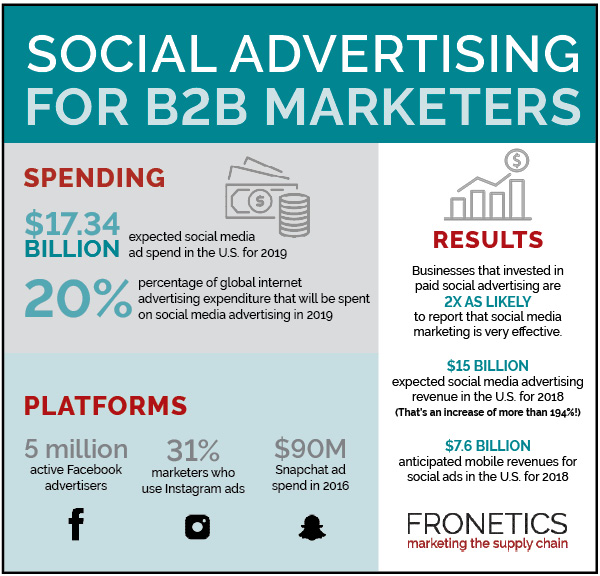
by Fronetics | Jun 11, 2018 | Blog, Content Marketing, Logistics, Marketing, Social Media, Strategy, Supply Chain
You have to take the long view with content marketing, allowing time for your strategy to develop, your brand to build authority, and your sales cycle to play out.
When you undertake a new content marketing program, you’re making a big investment. So it makes sense that you want to start seeing immediate results. But it’s important to understand from the get-go that content marketing doesn’t really work like that. Yes, you’ll start seeing incremental results within the first few months. But what we tell our clients is that things aren’t really going to start cooking with gas until the 12-18 month mark.
I’ve written before about why you shouldn’t give up on content marketing after a short period of time. While you’ll probably see growth in web traffic, improved social reach, and generally better engagement metrics like time on page, you’re not likely to see new leads or sales to speak of in the first few months after instituting a content marketing strategy.
And that can be hugely frustrating. But the key is understanding that content marketing isn’t a gimmick, and it’s not a short-term strategy. It’s a long-term solution that, if allowed to germinate and grow for the long haul, helps you build brand awareness, grow your audience, and generate new leads and sales. When it comes to content marketing, your goal is to be the tortoise, not the hare.
Content marketing is not a short-term solution
In fact, rushing your relationship with content marketing is one of the worst things you can do. Let’s talk about why that is.
First off, content marketing isn’t a one-size-fits-all solution. You need to develop a strategy that works for your business, and that doesn’t happen overnight. When we first engage with a client at Fronetics, we generally take 30-45 days to do an in-depth dive into the company’s data to develop a custom strategy that aligns with the client’s specific business goals. It feels exhaustive at times, but it always ends up paying off.
[bctt tweet=”According to the Content Marketing Institute, 11% of companies without a documented content marketing strategy find their efforts successful, compared to 60% of companies with a strategy in place. ” username=”Fronetics”]
Keep in mind that only 11% of companies without a documented content marketing strategy find their efforts successful, compared to 60% of companies with a strategy in place. And that number rises to 86% when the company designates someone to lead the strategy.
The bottom line? Skipping this step to rush to results will pretty much ensure that your efforts won’t be worth it.
Building trust
In addition to the time it takes to develop a strategy, becoming an authority — and earning the trust and loyalty of your audience — takes time. Your goal is to be a consistent source of information and value, building your brand as an expert in the area.
It goes without saying that this doesn’t happen overnight. But it’s extremely well worth the effort and the patience. Remember that the average B2B buyer consumes between two and five pieces of content before making a purchase decision. If you can position your business as the premier expert on the subject by having the best, most informative, most helpful content available, you’ll have a leg up in the buyer’s decision.
Let the sales cycle play out
Once your strategy is documented and in place, and you begin to create and curate consistent, well-researched, high-quality content, there’s also the process of letting your sales cycle run its course. You need to allow your target audience time to find you and complete thorough research about you and your competitors before making a decision.
After all, content marketing can’t shorten your sales cycle. But lead nurturing with content can keep moving your prospects down the sales funnel. And content can help your sales team close deals. But you can’t expect a buyer to read your first blog post today and make a big purchase tomorrow. That’s just not realistic.
I cannot urge you enough: Don’t give up on content marketing before you give it time work. Hang in there long enough for your initial investment to pay off, and don’t be afraid to adjust your strategy along the way. If you stick with content marketing, it will generate those leads and sales you’re looking for.
Related posts:


by Fronetics | Jun 7, 2018 | Blog, Content Marketing, Logistics, Marketing, Social Media, Supply Chain
Supply chain and logistics marketers need to incorporate social advertising into their content market strategy (and budget) to stay on top of marketing’s biggest driver.
The way audiences use social media channels is constantly changing. As marketers, we need to make sure we’re adapting to these changes. One of the biggest changes we’ve seen so far in 2018 is the increased use of social advertising.
Social advertising is a paid form of paid digital advertising on social media platforms. For example, the advertising platforms provided by Google, Twitter, and Facebook involve “targeting and presenting ads based on relationships articulated on those same services.” Oftentimes, social advertising is one part of a larger marketing strategy.
Sounds easy enough to implement, right? Well, there are so many options and so many more users. If you’re taking the time and money to invest in social advertising, you need to ensure that you’re using the right platforms and getting in front of your target audiences.
[bctt tweet=”With over 3.5 billion internet users worldwide, it’s easy to see the reach ads on social media platforms can have. Facebook alone has over 2 billion daily active users. 2 billion! ” username=”Fronetics”]
In Social Media Examiner’s new report, it’s hard to dispute that social advertising is anything but powerful. With over 3.5 billion internet users worldwide, it’s easy to see the reach ads on social media platforms can have. Facebook alone has over 2 billion daily active users. 2 billion! That’s a lot of opportunities for distributing your content and gaining new followers.
Here are some powerful statistics to prove the weight of social advertising and why it’s worth your time and pennies.
Infographic: A look at social advertising for B2B marketers

(Made with Canva)
Key takeaway
For the first time in years, Social Media Examiner’s report revealed that marketers are more focused on lead generation than cultivating a loyal fan base. What does this mean for you? The focus has shifted from engagement to metrics and automation.
As marketers, we need to watch for increased use of chatbots and other marketing automation tools that can help supply chain marketers become more efficient and more successful in earning and converting leads.
Related posts:

SaveSave
SaveSave

by Fronetics | Jun 6, 2018 | Blog, Content Marketing, Leadership, Logistics, Marketing, Supply Chain, Talent
Organizations that promote corporate social responsibility (CSR) are reaping the benefits of their good deeds, including increased brand awareness and employee satisfaction.
Corporate social responsibility is a hot topic these days. Generally speaking, it’s a pretty broad term to describe how a company is working to improve its community. Companies can demonstrate CSR in lots of different ways, including donations, employee volunteering, implementing environmentally safe processes, and more.
These efforts, whether large or small, say a lot about your organization. Companies that consistently demonstrate their commitment to CSR initiatives are recognizing their ability to help their community and acting on that knowledge.
[bctt tweet=”55% of consumers are willing to pay more for products from socially responsible companies.” username=”Fronetics”]
And the public is taking notice. 55% of consumers are willing to pay more for products from socially responsible companies. What does that mean for you? It means that corporate social responsibility is as good for your community as it is for your own brand.
Here are four major benefits of corporate social responsibility.
4 benefits of corporate social responsibility.
1. Increased employee satisfaction
The way a company treats its community says a lot about how a company treats its employees. People that feel respected and supported in their jobs are often more productive and satisfied at work. Giving your employees opportunities to volunteer, especially during working hours, creates a sense of community within your organization, as well as a connection to the surrounding community. Employees will gain motivation and pride in their work through these personal-development opportunities.
Employees that are actively involved in the community are also acting as brand ambassadors. The more engaged and invested they are in your organization, and the greater community, the more productive they will be. In fact, companies with highly engaged employees saw 21% better business profitability. What could be better than happy employees promoting your brand while helping their neighbors?
2. Improved public image
In today’s digital era, companies that demonstrate corporate social responsibility are gaining exposure — and praise — for their involvements. Your brand’s reputation can only benefit from good deeds in your community. Think about it: Consumers feel good when they buy products and services from companies that are helping their community.
Don’t miss the opportunity to publicize your CSR initiatives and spread the word about your community involvement. Tweet, post, and share your social programs. Letting the public know about your good deeds will only work to increase your brand’s public image.
3. Increased customer loyalty
In a 2016 Neilson survey, 56% of participants said “a brand being known for its social value” was a top purchasing driver. And 53% of participants said “a brand with community commitment” was a leading purchasing driver.
Customers are more likely to be loyal to your brand if your corporate values align with their personal ones. What’s more, millennials — the largest population, over baby boomers, by 2019 — are driving the market these days. According to Forbes contributor Sarah Landrum, millennials prefer to do business with “corporations and brands with pro-social messages, sustainable manufacturing methods, and ethical business standards.” CSR programs work to showcase your corporate values and demonstrate that team work, community involvement, and engagement are at the top of your core values.
4. Increased creativity
Want your employees to start thinking outside of the box? Want to increase innovation in your company? CSR initiatives encourage your employees to try new things and get re-energized about their jobs.
Through this social involvement, employees will feel empowered to start contributing to the bigger picture. They might come up with new ideas about products or internal processes or innovate new problem-solving solutions. When you demonstrate your company’s values and passions through community giving, employees will feel encouraged (and supported) to develop new and better ways to do their jobs.
CSR is a win/win.
A commitment to corporate social responsibility is no longer optional. Companies need to understand that CSR affects their internal (employee engagement, productivity, turnover rate) and external (increased sales, customer loyalty, brand awareness) growth. By creating and participating in CSR initiatives, companies have the opportunity showcase their core values and create trust among your employees and your buyers.
What corporate social responsibility initiatives have you implemented?
Related posts:

SaveSave

by Jennifer Hart Yim | Jun 5, 2018 | Blog, Content Marketing, Data/Analytics, Internet of Things, Logistics, Manufacturing & Distribution, Marketing, Strategy, Supply Chain
The Internet of Things is revolutionizing manufacturing and supply chain. Is your organization prepared?
This article is part of a series of articles written by MBA students and graduates from the University of New Hampshire Peter T. Paul College of Business and Economics.
“If you think that the internet has changed your life, think again. The Internet of Things (IoT) is about to change it all over again!”
This famous quote from co-founder of Aria Systems, Brendan O’Brien, sums up the significant role that the Internet of Things is playing now, and also its unlimited potential in the near future. The technology can be defined as the networked connection of physical objects.
[bctt tweet=”More than 1.2 trillion items on earth now have the potential to join the IoT network, but less than one percent of them are connected to the internet.” username=”Fronetics”]
Since 2014, Internet of Things is no longer a new term for most companies. However, this is just the beginning of the IoT revolution. More than 1.2 trillion items on earth now have the potential to join the IoT network, but less than one percent of them are connected to the internet.
And if we look at estimated worldwide spending on IoT through 2020, manufacturing, logistics and utilities are the industries that will spend the most money on this technology. This is partially due to their reliance on supply chain management. In addition, their supply chain networks are usually much more complex then companies from other industries.
The real value of Internet of Things is the data captured during the process, instead of the devices themselves. Nowadays customers are expecting higher quality products delivered in the shortest amount of time. That trend requires companies to have a more efficient supply chain in order to fulfill the demand. Brand matters less as it did a decade ago.
How to move products from the factory to consumers’ hands more efficiently becomes the new challenge for all players across all industries. Meanwhile, saving cost, adding asset velocity through enhanced transparency, as well as visibility are also the potential benefits by embracing the Internet of Things.
There are a number of IoT practices in supply chain:
Operational efficiency
Warehouses always play a vital role in a supply chain. It is also an area where IoT technology shows its magic by providing competitive advantages through data acquired from sensor networks. And generally, it can be improved from four aspects:
- Manufacturing maintenance – Sensors and robots linked to the internet increase up-times, reduce operational costs, and improve overall service quality. By visualizing and collecting data — such as temperature and equipment malfunction — managers are able to see and control operations on the floor in a real-time manner. Data collected in the IoT process can also be used in setting alerts for predictive maintenance. It works like HP Instant Ink, which will automatically order new ink when you the printer is about to run out of the old one.
- Inventory forecasting – As Vice President of IT at DHL Supply Chain Javier Esplugas said: managers no longer have to wait for weeks or months to get a report to have an understanding what happened during the last quarter. Instead, managers can make decisions on things that are happening now. Even companies using a 3PL can closely monitor the distribution centers and warehouses so that they can avoid prolonged cycle times and receive warnings in advance.
- Asset tracking – In a warehouse, scales and visual sensors can alert workers about fulfillment needs. The IoT also reduces human error for inbound and outbound records, requiring less human capital for one warehouse.
- Freight transportation – Logistics also holds a great potential for IoT networks. Today, sensors can track and monitor a container in a freighter in the middle of the sea or on a cargo flight. In the future, IoT will also be used to provide a more secure freight transportation environment. In 2016, around $3.7 million worth of consumable goods was stolen in cargo thefts in the U.S. The number of incidents reported in 2016 was 692. Through IoT technology, owners will have access to real-time information on the movement of goods.
Real-world examples
We’ve already seen leading car manufacturer BMW using IoT to improve its product lines efficiency. That is the most basic level of optimization within a warehouse.
A more thorough example would come from DHL. This global company actively involves IoT in different stages of its logistics process.
The journey of a package at DHL starts at the time it’s received by a carrier. By scanning the bar code or QR code on the package, it is formally recorded in the company’s system.
When the package arrives at the warehouse, basic information such as height, weight, and goods type will be collected as it enters the gate, providing accurate inventory control for workers. Sensors in the facility will be constantly monitoring the condition, as well as location of the items, giving workers a visual graph on the computer. When the package leaves the warehouse or sorting center, sensors built in the gate will collect information again for outbound items. Cameras attached to the gateways could also be used for damage detection.
They call the warehouse with all those systems the Smart Warehouse. And now they are testing the solution in multiple locations.
Due to the fact that DHL has been focusing on global logistics, its activities always include freight transportation. To reduce the inventory delays as well as the cost of stolen goods, DHL expects to set up location and condition monitoring through IoT. Ultimately, transport visibility and security functions will be enhanced.
What’s more, DHL’s Supply Chain segment is developing a software that gives clients a way to manage global supply chain risk by providing alternatives. The tool can find other optimized solutions by leveraging data collected from connected objectives.
Last-mile delivery
It makes a lot of sense to introduce IoT to warehouse management or freight transportation. However, for last-mile delivery, it can be a very different story. This final part is highly dependent on labor.
Carriers use data collected from vehicles for road condition in order to optimize the route. Before delivery, they would send notification to the end-customer, who has the choice to either accept the scheduled delivery time or re-schedule the delivery.
The future
By the year of 2020, the number of devices connected to the IoT will be over 50 billion. But that’s still just 3 percent of the number of all things on earth.
JDA’s Intelligent Manufacturing Survey discovered that 57 percent of manufacturers were going to incorporate IoT into their digital supply chain strategy. However, according to an Accenture report, up until the beginning of 2017, 88 percent of manufacturing executives were not prepared to adopt the technology. This is going to benefit companies that are willing to be the first movers and create barriers for the rest to catch up.
So, is your company ready for the digital revolution?
About the author
Xiaoxue Liu, originally from China, is a current MBA student at University of New Hampshire, with a huge interest in supply chain digitalization.
Related posts:


by Jennifer Hart Yim | Jun 4, 2018 | Blog, Content Marketing, Current Events, Logistics, Manufacturing & Distribution, Marketing, Supply Chain
3-D printing opens up new revenue opportunities for supply chain, helping companies meet demand in real time, manage inventory without limiting products they offer, and increase lead time.
This article is part of a series of articles written by MBA students and graduates from the University of New Hampshire Peter T. Paul College of Business and Economics.
Spring has finally arrived in New England. However, with spring comes every vehicle’s most dreaded enemy, the pothole! My coworker Will recently fell victim to one such nemesis. His part-sourcing saga has me wondering how soon the narrative may change.
On what started as a normal morning, Will soon found himself calling a tow truck to get his car to the shop and a coworker to get himself to work. An unavoidable pothole caused one of his ball joints to fail, and limping anywhere was not an option. The silver lining of the day was that his very accommodating mechanic agreed that Will could source his own parts.
A sourcing saga ensued.
The layers of research he had to do was frustrating. Which manufacturers make the quality of product he wants? Then which distributors can provide him the quantity he needs when he needs them at the best price?
This meant calls to local auto part stores, price checking against online distributors, verifying brands & model numbers, accounting for lead times, stockouts, shipping and handling fees to determine how to get the best total value of quality, cost, and delivery.
Complex decisions like this are common in many sourcing scenarios.
But does it have to be?
What if distributors could better manage their inventory without limiting the products that they offer or increasing the lead times to their customers?
With 3-D printing, that may soon be attainable.
Rather than holding inventory from various manufacturers, a distributor could have license agreements with manufacturers to print parts on demand.
Revolutionary though this sounds, it’s not an unfamiliar model. Not so long ago, buying music meant going to a physical store to purchase or order an album. Now streaming services have license agreements with record companies to meet consumer demand in real time.
Jay Leno has been 3-D printing parts for his fleet of classic cars for nearly a decade. He admitted that initially the costs were prohibitive for most people. However now that 3-D printers are available at a wide range of price points, it is becoming more economical to print products on demand.
Printing parts with low inventory turns on demand would reduce inventory costs within the entire supply chain, having a positive impact on a company’s bottom line. High-value, low-volume parts like those of late model vehicles are the perfect candidates. In fact, BMW, Porsche, and Mercedes-Benz Trucks have begun 3-D printing spare parts older models and freight trucks.
3-D printing and logistics
The next logical progression to reduce overall supply chain cost is to move production as close to the customer as possible. Logistics companies are positioning themselves to be ready to integrate into this production model.
Both UPS and DHL have recognized the potential for end-of runway 3-D print capabilities and local 3-D “print shops.” UPS has partnered with SAP and Fast Radius to launch its On-Demand 3D Printing Manufacturing Network, which leverages 3-D printing technology, analytics and UPS’s global network to execute production at the location where capacity and logistics are optimum.
This summer, BMW Motorrad will provide spare-part printing capability directly to customers with BMW Motorrad iParts, a mobile 3-D printer designed to travel with you on the back of your BMW Motorrad motorcycle. Customers will use a mobile app to download a part file from the cloud-based library and print parts on the go. Although limited by the size of the printer, Motorrad rides will be able to replace small parts in nearly any location. Customers can even preload files so, no matter where they are — the side of a mountain or the middle of a desert — they can make spare parts.
These companies are not alone in seeing the value of 3-D printing on the go. Amazon made headlines when it first filed for a patent on a 3-D printing delivery truck. That patent was granted at the beginning of this year. Although a launch plan has not been announced, a major player with that capability is a definite catalyst for more innovation at the intersection of 3-D printing and logistics.
The future
[bctt tweet=”It’s clear that logistics and inventory management will not look the same 10 years from now. The question is: when and where it will be economical to print parts on demand?” username=”Fronetics”]
It’s clear that change is coming, logistics and inventory management will not look the same 10 years from now. The question is: when and where it will be economical to print parts on demand? Will it be at an end-of-runway distribution center, a local multipurpose 3-D printing shop, or on-site at repair shops? Will AAA be able to print a new ball joint in a roadside truck and change it out like it was no different than the services they offer for tires and battery today? I can’t wait to find out.
In the meantime, Will had to deal with today’s sourcing options. After many phone calls, dozens of emails, and multiple carpools to work, his car is back on the road. And he believes he got four new ball joints at a good value.
About the author
Ruth DeMott is a quality engineer at Pratt & Whitney currently pursuing an MBA at the University of New Hampshire. She holds a BS in Industrial Engineering from Worcester Polytechnic Institute (class of 2010). She has held roles of increasing responsibility in the manufacturing and quality engineering departments since joining Pratt upon completion of her undergraduate degree. She is involved in the New Hampshire Youth Rugby program, enjoys traveling, putting things together, and spending time with friends and family.
Related posts:


by Fronetics | May 31, 2018 | Blog, Content Marketing, Current Events, Marketing, Social Media
Also in social media news May 2018: Pinterest gives businesses more control over how users view their content, Snapchat offers skip-free ads, and Facebook is re-opening application reviews and chatbot development.
At the beginning of May, Facebook hosted its annual developer conference, Facebook F8. This year’s keynote speaker, CEO Mark Zuckerberg, focused on rallying developers to continue building for his platform, despite the recent controversies.
Facebook also used its annual conference to kick off some new initiatives, including:
- Clear History: a new privacy feature allowing users to delete data Facebook has collected from sites and apps that use its ads and analytics tool. This will allow users to scrub some of their browsing history from Facebook’s data store.
- Instagram’s new video chat: Instagram’s messaging has lacked video chat capabilities, until now. The new feature was created to win over users who currently prefer Snapchat for video chat.
- Translation abilities on Messenger: Facebook is slowly integrating translation abilities for Messenger, starting with English to Spanish translation, with hopes to expand to other languages in the future.
[bctt tweet=”Clearly WhatsApp is doing something right, announcing their stories feature, WhatsApp Status, officially reached 450 million daily active users. ” username=”Fronetics”]
But Facebook isn’t the only social media giant looking to gain new traction with users. WhatsApp, Snapchat, and even Pinterest have been making changes to increase user engagement. And clearly WhatsApp is doing something right, announcing their stories feature, WhatsApp Status, officially reached 450 million daily active users. This is a tough reality for Snapchat, who previously dominated the video stories space, but now only has a fraction of the daily users as WhatsApp.
Here’s your social media news for May 2018.
Marketers prepare for European Union’s GDPR laws
The European Union’s General Data Protection Regulation (GDPR) is a new set of laws that provide “greater protection for consumers’ privacy and set strict guidelines on how personal information is collected, stored, and used.” These radical new laws will dramatically affect the way user data is collected and stored by businesses in Europe, including U.S. companies that do business abroad. The laws officially go into effect on May 25, 2018, nearly two years after they were initially passed by the Parliament. Fronetics is staying on top of these changes and will provide updates on any changes that occur.
Facebook clarifies advertising processes and data practices
At Facebook’s F8 conference, the platform explained the basics of how Facebook advertising works and answered tough questions about its advertising practices. Vice President of Ads, Rob Goldman, writes “We do not tell advertisers who you are or sell your information to anyone. That has always been true. We think relevant advertising and privacy aren’t in conflict, and we’re committed to doing both well.” He also highlighted how users can control, manage, and even delete their data from the site to opt out of ads.
Snapchat tests 6-second unskippable ads
On May 15, Snapchat started running six-second unskippable ads on select Snapchat shows. Once reluctant to run ads on their app, Snapchat is opening up to the idea after a tough year since becoming publicly traded. The new ad format called, yes, Commericals is hoping to boost advertising revenue and increase business opportunities.
Pinterest rolls out new business profile and insights
Pinterest just announced its new business profile that allows brands to “highlight the content that they want customers to see first such as their latest pins, specific boards, or most recent Pinterest activity on their site.” The new feature also allows brands to create statistics reports, including the total number of people who saw or shared your pins in the past month. These new changes are expected to go live in the next couple of months.
Facebook reopens app review process
In light of the Cambridge Analytical scandal, Facebook had stopped all application review and chatbot development efforts to focus on its privacy and data policies. But they have officially reopened the app review process “after making some changes to make it more comprehensive and grounded on ensuring that each of [its] APIs creates value for people, is transparent, and builds trust.” The improvements to Facebook’s platform policies and programs hope to encourage continued use of its products, including chatbots.
Instagram experiments with improved explore section
Not far off from Facebook’s tried, and failed, Explore Feed, Instagram is now testing a redesigned Explore tab for users to discover new content and organize that content into relevant topic channels. The new tool “is still personalized for you, but the content is now organized into topic channels, so you can browse across your interests and go deeper on any area you’d like.” The Explore tab will be available in the next few weeks.
Instagram adds improved tools for businesses to connect with customers
Instagram is adding the ability for businesses to receive new messages from customers. Originally these messages were filed into a pending folder and now they’ll be available directly in a business’ inbox. The app is also added improved call-to-action buttons, “which allow users to complete transactions through popular third-party partners without having to leave Instagram.” Additional features include the ability for businesses to star and filter customer messages.
Related posts:











